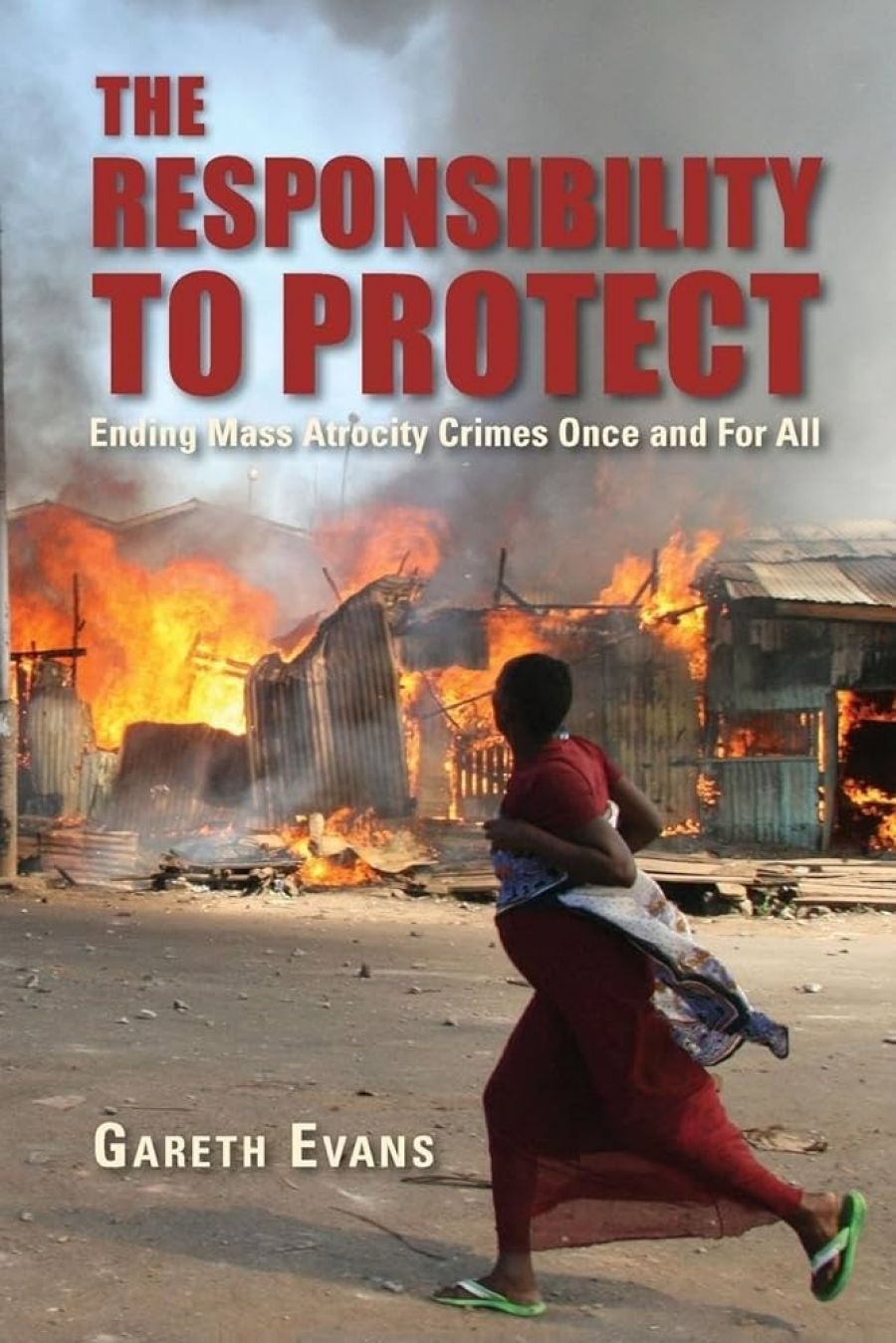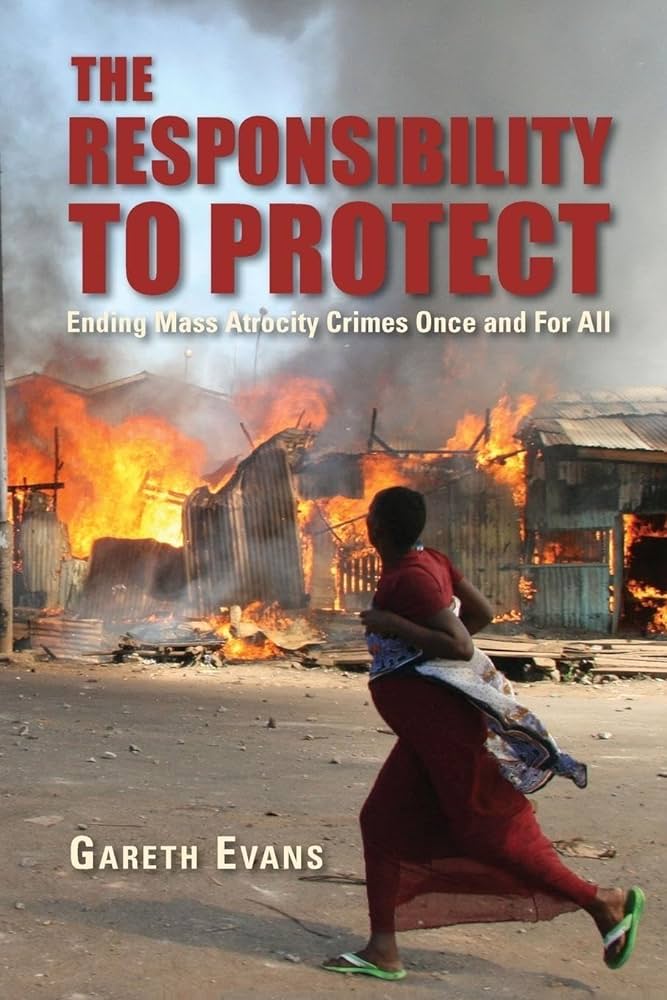
- Free Article: No
- Contents Category: Politics
- Review Article: Yes
- Article Title: The norm entrepreneur
- Online Only: No
- Custom Highlight Text:
Gareth Evans has strong claims to being the most influential Australian political figure of the past half century on the international stage. As foreign minister, he helped bring about the Cambodia peace settlement and negotiate the Chemical Weapons Convention. His energetic post-political life has encompassed the leadership of an outstanding non-government organisation, the International Crisis Group, and participation in the work of several important international commissions. His book is an account of the emergence of a new international norm – the responsibility to protect – by the person who has done more to develop it than any other: the ‘norm entrepreneur’ himself, in the language of some international relations theorists.
- Book 1 Title: The Responsibility to Protect
- Book 1 Subtitle: End mass atrocity crimes once and for all
- Book 1 Biblio: Brookings Institution Press (UniReps), $39.95 hb, 348 pp
- Book 1 Cover Small (400 x 600):

- Book 1 Cover (800 x 1200):

International norms are the generally agreed, self-imposed rules of behaviour which nations adopt in dealing with each other. They mark the slow progress of the global system from anarchy and barbarism to something more like civilisation. Attitudes towards actions which at one point in history are considered natural and inevitable – say, the enslavement of civilian victims of armed conflict – shift or are shifted over time until they finally fall outside the acceptable range of behaviour by states. Such norms are slow to develop, fragile and easy to reverse. So when a new norm begins to take shape, it is worth paying attention.
The responsibility to protect (or R2P, as it has more jauntily been branded) addresses one of the most difficult problems of our time: how should the international community react when it is confronted by conscience-shocking crimes of genocide, ethnic cleansing or mass slaughter, when these occur within the borders of an individual state?
Gareth Evans became Australian foreign minister in 1988, just as the Cold War was ending. Although this was an unexpectedly benign coda to a dire century, one sorry consequence was that national and regional tensions which had been kept in check by East-West competition in Africa and the former Yugoslavia were unleashed explosively. In Somalia, Rwanda, Bosnia, and Kosovo, the international community was confronted by what are described here broadly as ‘mass atrocity crimes’. But the response in each case was, as the author puts it, ‘too little, too late, misconceived, poorly resourced, poorly executed or all of the above’.
The international debate about what should be done in the face of genocide in Rwanda and massacres in Srebrenica raged, but conceptually there was a problem. Did other states have a right in such cases to ride to the rescue of affected populations, a right of humanitarian intervention? Or was such action, however morally desirable, trumped by the powerful (although by no means obviously self-evident) idea, dating back to the Peace of Westphalia in 1648, that in all things within its own borders the individual state is sovereign?
This was not as easy an issue as it might have seemed to the understandably shocked sensibilities of Western societies. The developing world, the ‘global South’, had, after all, spent much of the nineteenth and the first half of the twentieth centuries experiencing first-hand the impact of other people’s ideas of missions civilatrices. For good reasons as well as bad, many post-colonial states were strong supporters of the idea of non-intervention in the internal affairs of other countries. So, as the twentieth century ended, this question of a ‘right to intervene’ was deeply unresolved.
In 2000 the Canadian Government invited a group of experts from around the world to explore the issue. Evans was appointed as co-chair of this International Commission on Intervention and State Sovereignty (ICISS). He had a long interest, which he traces to the lessons of the Cambodian killing fields, in improving international responses to mass atrocity crimes. He had already begun traversing the territory in his book Cooperating for Peace: The Global Agenda for the 1990s and Beyond (1993), written when he was Australian foreign minister.
The Canadian commission brought a conceptual breakthrough. Evans argued to his fellow commissioners that, instead of talking about a right to intervene, the international debate should instead be reformulated around the idea of a responsibility to protect. The key shift here, which drew on work by Francis Deng and Kofi Annan, was to reconceptualise state sovereignty not as control, the traditional Westphalian approach, but as responsibility, including the responsibility to protect the inhabitants of the state from atrocity crimes. Evans hoped that this would enable entrenched opponents to find new ground on which to engage, because ‘with a new script, the actors have to change their lines and think afresh about what the real issues of the play actually are’.
The report was a significant contribution to international thinking, but it was published just as the terrorist attacks of 9/11 dramatically changed the international conversation. After the collapse of the Twin Towers, who was still interested in humanitarian intervention?
Fortuitously, Evans was appointed to another major commission, the High Level Panel on Threats, Challenges, and Change, which Secretary-General Kofi Annan established as part of the preparation for the 2005 World Summit to mark the sixtieth anniversary of the United Nations.
That summit was a dismal failure on most counts, but it left an important legacy by securing, in its final document, the unanimous endorsement of world leaders of the notion of a responsibility to protect.
Evans’s book explores why and how the idea developed, and what it means. Within the overall scope of the responsibility to protect, he identifies three quite distinct roles for the international community: a responsibility to prevent a situation which might lead to mass atrocity crimes from developing; a responsibility to react when it has happened; and a responsibility to rebuild societies which have been shattered by such conflict. Of these the greatest, he emphasises, is the responsibility to prevent.
As one would expect, given Evans’s background and temperament, this is much more than a work for academics or theorists. The second part – two thirds of its length – is entitled ‘Operationalizing the Responsibility to Protect’. It speaks to policy makers in particular, providing a valuable checklist of what should be done when a crisis arises and a useful toolbox of responses.
The book is an argument shaped to encourage the doubtful and to keep the coalition together. Evans realises that the debate is not over, that foot-dragging and second thoughts are already underway, and that if the ambit of the norm is stretched too far it could break. He argues against the concept’s friends as much as its opponents. Much of the public interest in this question (and a great deal of the work within governments) has centred around military interventions. But Evans is keen to put this into perspective. He is not making a case, he stresses, for international action against odious regimes simply because they are odious, but for a range of responses which might in extreme but very limited circumstances include military intervention. Such intervention should, he believes, be undertaken only (or, as he argues in a particularly interesting and subtle reflection, almost only) under the mandate, and therefore with the legitimacy, of the United Nations Charter, however difficult and frustrating this may be.
Evans is an optimist. He believes that ‘even the most horrible and intractable problems arc solvable’. He has spent a fruitful public career prodding, demanding, arguing, wearing down opponents and exhausting his friends in that very cause. ‘Of almost any spread of options, inertia will have the numbers,’ he writes at one point. Not if Gareth Evans has anything to do with it. Readers of the book and, above all, potential future victims of mass atrocity crimes who will never know of its existence have reason to be grateful.


Comments powered by CComment